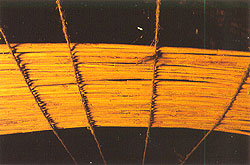


A well-made cinnamon quill, or "pipe," is a slim cane of uniform thickness, colour and quality, with edges neatly joined in a straight line end to end and looking like a tight roll of golden-brown multi-ply paper. Quills must be firm, compact and free from "foxing" - trade jargon for reddishbrown warps caused by damp. Quills are packed in 45-kilogram bales and classified into 10 grades according to diameter and the number of 42-inch quills to a pound; permissible amounts of foxing are specified for each grade. Quills are sometimes "buffed" with sulfur for markets with a preference for light-colored bark. Chips, referred to as "quillings" and "featherings," are sold as medium-quality cinnamon for grinding into cinnamon powder, sold on its own or as "pudding spice" in a compound with nutmeg, clove, cardamom, mace and allspice. The chips are also sold for the distillation of oil.
Cinnamon trees have a productive life span of about 40-50 years after which they have to be replanted, for which cinnamon growers receive generous subsidies from Sri Lanka's Department of Minor Export Crops. Well-tended trees free of diseases such as leaf blight and white root yield about 100 kilograms of cured bark per acre.
Cinnamon fetched peak prices in 1989 averaging US$7.50 for a kilogram of the best quality, but fell to US$5 last year. The Gulf War temporarily set back the spice trade, but local exporters believe that cinnamon has a buoyant demand in world markets and will recover quickly. Continued...
